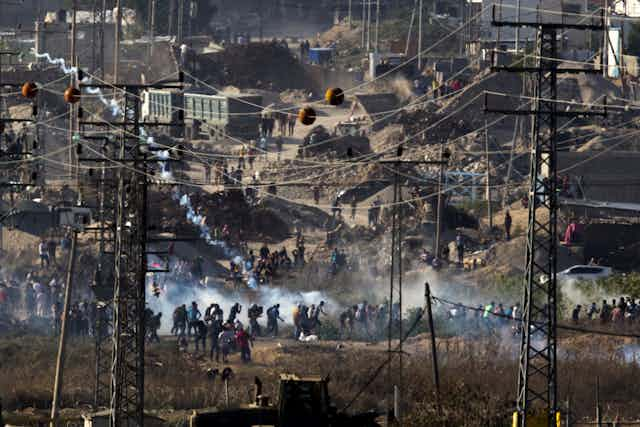The next visit of the Middle East Quartet to Jerusalem and Ramallah will take place against a backdrop of serious unrest. The violence re-emerged last month and clashes have become a daily occurrence in Jerusalem, Gaza and the West Bank, resulting in the deaths of 24 Palestinians and four Israelis.
This has been fuelled by an array of issues, among them restrictions on movement around the Old City and al-Aqsa mosque compound; tensions at the checkpoints; the sustained construction of illegal settlements; attacks by settlers on Palestinians and vice versa; home demolitions and peace talks that have yet to effectively promote a higher, equal price on life on the ground.
In response to the unrest, the mayor of Jerusalem, Nir Barkat, advised gun-owning civilians to carry their weapons at all times “like military reserve duty”. While carrying arms is a common sight around the settlements, the call for residents of Jerusalem to do likewise is a negative development. The addition of more arms will not hasten the end of the conflict, but rather its escalation.
‘War’ on stone-throwers
The resurgence of violence has been linked to the restrictions placed on access to the al-Aqsa mosque compound during Rosh Hashanah in mid-September, which resulted in three days of clashes between Israeli police and Palestinian protestors.
In response to the protests and the death of Alexander Levlovitch, an Israeli driver, Israel’s prime minister Benjamin Netanyahu declared a “war” on stone-throwers through the implementation of tougher penalties on children who throw stones, as well as their parents; a minimum sentence of four years in prison for adult throwers and new rules on opening live-fire. Under the extended measures approved by the security cabinet on September 24, Israeli forces can fire .22 calibre live rounds from Ruger rifles both when their own lives, and the lives of others, are perceived to be at risk.
While Israeli officials have defended the regulations as necessary and “non-lethal”, humanitarian organisations argue that “two-two” bullets have been responsible for the deaths of four Palestinians since the start of the year, the latest being a 13-year-old boy, Abed a-Rahman Abdallah, who was killed in Aida refugee camp near Bethlehem on October 5.
According to Israeli human rights group, B’Tselem, the introduction of the “two-two” to East Jerusalem is “expected to have lethal consequences”, while the extended authorisation is seen as further evidence of Netanyahu’s lack of vision and understanding when it comes to ending the conflict.
Intifada: part three
As the unrest approaches the one-month mark, the Hamas leader, Ismail Haniyeh issued the call for a “Third Intifada”. Following on from the First Intifada (1987-1993) and the Second Intifada (2000-2005), the current unrest has also been called “the Silent Intifada”, the “Urban Intifada” and the “Jerusalem Intifada”.

For some, the prospect of a new intifada brings caution and concern; for others it is less an intifada and more “a wave of Palestinian terrorism”. The reluctance to apply the term is indicative of its symbolic power: when Knesset member, Haneen Zoabi, from the Joint List (the coalition of Arab-dominated parties in the Knesset called) for “popular support” for those resisting the restrictions in the Old City, Netanyahu asked the attorney-general, Yehuda Weinstein, to open a criminal investigation on the basis of incitement to violence. For Zoabi, Netanyahu’s response reflects the sentiments of the right-wing government, his speech marked by “crazed words of incitement [and] a moral and political bankruptcy”.
When couched in the broader conflict, the current unrest stands as both a return to protracted outbursts, as well as a testament to the failure of the peace talks that preceded it. For both Netanyahu and the Palestinian president, Mahmoud Abbas, the violence is yet another bout – one in which Netanyahu is keen to sustain the occupation at any cost, while Abbas poses as the reluctant opponent thrown in on the third round. As Hasan Qureishi observed: “Arafat made things happen. Abu Mazen reads the news.”
Distance and despair
The past two decades have brought a new generation of Palestinians and Israelis to a time marked by recurrent tensions, wars and restrictions, whether formally or informally. For some Israelis, the West Bank evokes the “the Wild West”, a place to be avoided or entered cautiously; for Palestinians, crossing the border into Israel is perilous, if not fatal, depending on the route taken.
For the protesters engaged in the street clashes, the hope that surrounded the Oslo Accords has become either a distant memory or a sentiment that was never experienced. The Third Intifada marks a bursting point in the frustrations that have accumulated over the years and while the Quartet will look to piece together confidence-building measures, the real challenge lies in the streets and homes on the ground.

